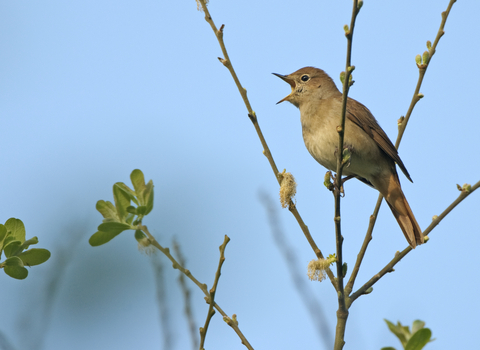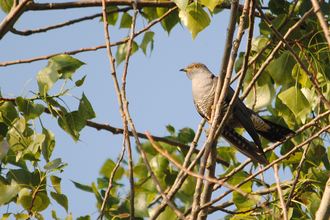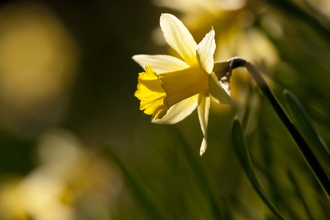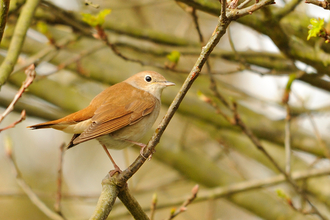Cuckoos and nightingales
A fast succession of high, low and rich notes that few other species can match, the nightingale's song is famed for its complex beauty. Arriving in April, the robin-sized bird sings its melodies throughout the night and day until late May and early June, often from within the shelter of dense scrub. Around the same time, the dove-sized cuckoo, which lays its eggs in the nests of other birds, brings its infamous two-note call; announcing to all that spring is here.
The arrival of nightingales and cuckoos is an eagerly awaited sign of spring
Find cuckoo and nightingale near you
Do a little research in advance and find out some of the best Wildlife Trust reserves to see and hear nightingale and cuckoo. Sadly, census data has shown that nightingale numbers have strongly declined in recent decades. Causes of decline include habitat loss due to grazing roe and muntjac deer, which have reduced the density of shrubs much-needed by nightingale.
North
Yorkshire
Broadhead Clough - Gorgeous upland woodland, typical of these acidic soils with oak, birch and holly, Broadhead Clough Nature Reserve offers a spectacular Pennine landscape with a dramatic past. An invigorating climb through the tranquil mature woodland is rewarded by emerging on the top of the world, with stunning views back over the valley just climbed.
Paull Holme Strays - Paull Holme Strays lies alongside the mighty Humber Estuary offering spectacular views across the south Holderness landscape including local historical features. Managed in partnership with the Environment Agency who recently carried out major flood prevention works to help protect the City of Hull and surrounding areas from future flooding.
Carlton Marsh - A wetland nature lover’s delight and a core wildlife site of the Dearne Valley, Carlton Marsh hugs the Cudworth Dyke and is best viewed from the footpath on the old railway line running the length of the site.
South
Cambridgeshire
Grafham Water SSSI - Loaded with spring delights, including the melodic song of the nightingale and the spring chorus of the garden warbler and nightcap. Also making use of the reservoir includes the common sandpiper, greenshank and the rare red-throated diver. With nine miles of shoreline, and around 170 species of bird recorded each year, there is always something to see.
The Great Fen also offers opportunities to see and hear these enigmatic birds.
Devon
Emsworthy Nature Reserve - Cuckoos are heard in May at Emsworthy nature reserve. A lovely reserve, the small internal fields are defined by dry stone walls and contain a wet valley mire and stream. Toads, frogs and adders are abundant within the lower and upper mire areas, while the wet areas also attract a number of dragonfly and damselfly species. Barn owls have often been spotted at Emsworthy, while cuckoos, tree pipits and stonechats together, deliver a spring chorus.
Essex
Fingringhoe Wick - Set in a spectacular position overlooking the Colne Estuary in north Essex, it is a wildlife haven, with diverse habitats attracting hundreds of different bird species and wild flowers. It is arguably the best place in the country to hear nightingales. In late April and early May, it hosts the astonishing sound of dozens singing their hearts out at full throttle, with 30-40 males singing each year. Essex Wildlife Trust regularly runs evening Nightingale Walks.
Other Essex Wildlife Trust nature reserves where, among others, you can hear nightingales, include Abberton Reservoir, Copperas Wood, Cockaynes Wood, and Stanford Warren.
Kent
Bough Beech Visitor Centre - An important staging post for migrating birds during the spring and autumn, Bough Beech is one of the most celebrated and visited bird watching sites in the south east. Regular appearances include the osprey, grey heron, little egret and little ringed plover. Both the call of the cuckoo and the nightingale can be heard here, while the surrounding grounds are great for spotting toads, dragonflies and great crested newts.
Norfolk
Trinity Broads - While the cuckoo has been well studied during the breeding season in the UK, very little was known about the migration routes they take or where in Africa they spent the winter. There has only been one recovery of a young bird that was found in mid-winter in Cameroon and that was 82 years ago. If we can pinpoint areas of importance then we can look at pressures there that might explain the decline of the British cuckoo.
Sussex
Woods Mill - This flagship environmental education reserve for Sussex is perfect for hearing the melodic song of the nightingale. Providing a peaceful setting, comprising coppice woodland, meadows and a large reed-fringed pond, the reserve is also home to woodpeckers, warblers, turtle doves and dragonflies. Facilities include a car park, toilets and a disabled path around the reed fringed pond, which passes through nightingale territory.
Wiltshire
Clouts Wood - Spring walks full of surprises – mossy gnarled boles contorted into fantastic shapes, marshy areas, hollowed trunks, running water and tumbled bridges. Most trees here are between 50 to 100 years of age, although some oaks are as much as 200 years old. Visit to hear the calling of the cuckoo and the patter of foxes, badgers and squirrels. Fascinating flora includes the nettle-leaved bellflower, bath asparagus (also known as the spiked star of Bethlehem) and stump puffball.
Midlands
Lincolnshire
Whibsy Nature Park - This landscape, once barren and lifeless, now abounds with life including the soothing song of the nightingale for which it is now famous. Whisby Nature Park has reclaimed the quarrying landscape of pits and bare sand. In spring and summer, flocks of tits and finches are joined by warblers. The lakes attract feeding sand martins and swallows, and terns nest on the islands. Chiffchaffs, reed and sedge warblers can be heard. Unlike the national trend of the nightingale, currently, the species population remain stable here.
Northamptonshire
Irthlingborough Lakes and Meadows - At the heart of the Nene Valley, Irthlingborough Lakes and Meadows is an internationally important wetland and stop-over for thousands of wildfowl and waders. Bordering the River Nene, the site is home to wintering golden plover, wigeon and gadwall, while in spring it resounds with the songs of cuckoos, nightingales and warblers. Around the river and lakes, fragments of precious meadows survive, awash with fragrant meadowsweet and common spotted orchids.
Glapthorn Cow Pastures - An important nesting site for cuckoos and three or four nightingale pairs that usually breed in the reserve. They can be heard singing during May and June. Many other birds breed here, especially warblers and maybe nuthatches. A spring visit in the early evening maybe rewarded with the sight and sound of male woodcock roding overhead and uttering their characteristic calls as it becomes dark.
Staffordshire
Highgate Common Nature Reserve - Cuckoos are aplenty on Highgate Common, an ancient lowland heath near Wombourne in the West Midlands. Buzzing with rare wildlife, this lowland heath is home to 5,000 different types of insects ranging from dragonflies, rare glow worms, countless beautiful butterflies, beetles, wasps and bees. If insects just aren’t your thing, don’t worry! Highgate Common’s heathland is also home to Grass Snakes, Common Lizards and Slow Worms! The heathland is also visited by wonderful bird species including the cuckoo, yellow hammer, tree pipit and skylark.
Warwickshire
Brandon Marsh Nature Reserve - Cuckoos are present at this nature reserve, near Coventry, and can be seen and heard all over it. The wildflower meadow here is full of cowslips in spring but is at its best in midsummer, when ox-eye daisies, yellow rattle and knapweed add a fine splash of colour. A pond provides a breeding site for frogs, toads and smooth newts. Along the attractive woodland walk, birds such as jay, bullfinch and blackcap may be seen.
Wales
Powys
Gilfach - A brilliant reserve to hear cuckoo calling.
Tylcau Hill (Flossie Brand) is also great for the more adventurous, and you stand a good chance of seeing them here. Both male and female cuckoo have thrilled visitors, two springs running, calling from a tree or perched on the wires. Other birds include redstart, linnet and pied flycatcher. Butterflies and moths include the small pearl-bordered fritillary, green hairstreak and the brightly coloured scarlet tiger moth.
Northern Ireland
Ulster
Ballynhone Bog - Northern Ireland's second largest area of intact raised bog, Ballynhone bog supports a rich diversity of wildlife including an incredible range of bog flora. The bog and surrounding birch woodland is very rich in birds including cuckoos, curlew, skylark, song thrush and reed bunting.The site is also important for dragonflies and butterflies, including the biggest known colony of the large heath butterfly in Northern Ireland. All of the region’s amphibians and reptiles can be found here including the likes of the common lizard and smooth newt.
What to look for
Despite what you may have heard, nightingales don’t only sing at night. If anything, they will be loudest first thing in the morning, so be prepared to get up early. Nightingales can be found in broadleaved woodlands, south of a line drawn between the Humber and the Severn. They sing from the densest bushes and shrubs, so you are a lot more likely to hear their loud song than you are to see this shy singer. Make sure you have listened to the song of the nightingale, either on The Wildlife Trusts’ soundcloud or elsewhere so that you know what to listen for.
If you can't get to these sites
If you can’t get to the special places listed above, there is a wonderful short film of Fingringhoe Wick’s nightingales on Youtube. The nightingale may be the most famous of our songbirds, but there are other birds with perhaps a more tuneful song. Song thrush, robin and blackbird can all give the nightingale a run for its money, and you can hear those in your own garden.
More wildlife experiences
From seeing colourful wildflowers to spotting magnificent birds of prey, we can help you get closer to wildlife across the UK.








